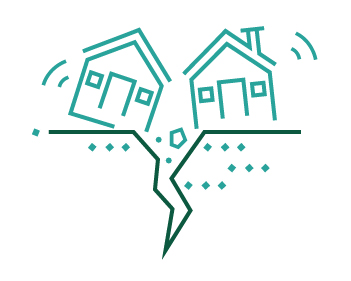
Earthquake Safety and Recovery
Earthquakes can strike most anywhere at any time, and real-time scientific data shows they do. Further, statistics show the number of major earthquakes worldwide has increased during the past decade. No matter the location, it’s clear casualties and property damage are mitigated when people are prepared, and homes and other structures are built to the latest codes. Below are helpful tips.
How to Prepare for an Earthquake
Earthquakes can strike most anywhere at any time, and real-time scientific data shows they do. Further, statistics show the number of major earthquakes worldwide has increased during the past decade. In the United States, Alaska and California have the most earthquakes annually, many of them small enough they aren’t felt. But larger ones can, and do, happen anywhere, including the Midwest and along the East Coast.
No matter the location, it’s clear casualties and property damage are mitigated when people are prepared, and homes and other structures are built to the latest codes. Communities and homes not ready for earthquakes can suffer loss of life and major infrastructure damage. Resulting fires can damage power and gas lines, and fighting fires can be disrupted if water lines are broken.
The International Codes (I-Codes) prescribe designing structures to be earthquake resistant and resilient in design and construction. More stringent codes are recommended for areas where earthquakes occur more often, as well as for buildings that need to be operational immediately following a disaster, such as police and fire stations and hospitals.
If an earthquake occurs in a populated area, it may cause deaths, injuries and extensive property damage. Here are some helpful tips to prepare your family and protect your home:
- Plan and hold earthquake drills for your family. To learn more about planned earthquake drills in your area, visit the Great ShakeOut Earthquake Drills website.
- Identify two ways to escape from every room in the home.
- Keep a flashlight and sturdy shoes by each person's bed.
- Select a safe location away from the home where your family can meet after evacuating.
- Have an earthquake kit containing enough water, food, medicines and other necessities for at least three days.
- Hire an inspector to make sure your home is securely anchored to its foundation.
- Strap water heaters, appliances and TVs to wall studs.
- Anchor bookshelves, heavy furniture, appliances and televisions to wall studs.
- Secure pictures, mirrors and ornaments to the wall with appropriate fasteners.
- Know where and how to shut off electricity, gas and water services.
Seismic Functional Recovery Portal
The term “seismic functional recovery” means that buildings are not only designed and constructed for life safety, but also to support the basic intended functions of the building’s pre-earthquake use and occupancy within a maximum acceptable time.
The Code Council offers a "one-stop" source for this information at our Seismic Functional Recovery Portal.
Additional Resources
- FEMA P-530 Earthquake Safety at Home
- Earthquake safety tips from FLASH
- Reconnect and recover
- Earthquake Preparedness Guide: For People with Disabilities and Others with Access and Functional Needs
- What NOT to do during an earthquake
- Emergency evacuation kits
- Earthquake safety video series
- Earthquake safety tips from the American Red Cross
- Protecting your home from earthquakes
- FEMA Earthquake Resources
- Hazard-Resistant Building Code Documents
- FEMA Building Codes Save: A Nationwide Study of Loss Prevention


